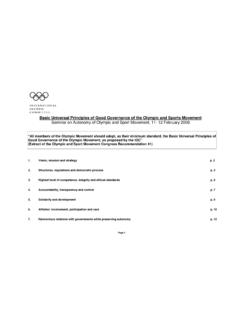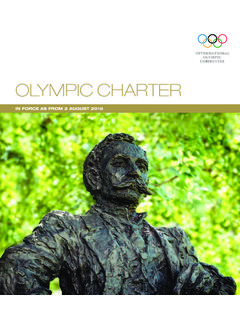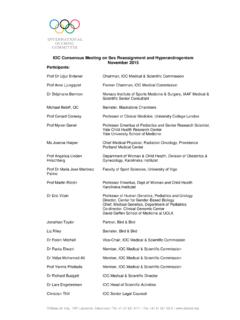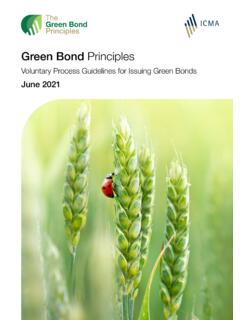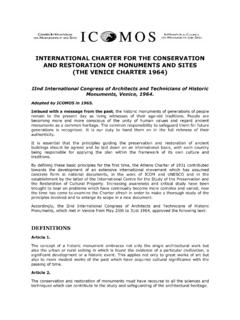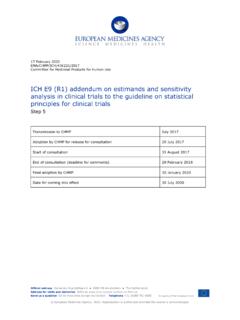Transcription of OLYMPIC CHARTER
1 OLYMPIC CHARTER . IN FORCE AS FROM 15 SEPTEMBER 2017. OLYMPIC CHARTER . in force as from 15 september 2017. Table of Contents Abbreviations used within the OLYMPIC Movement .. 8. Introduction to the OLYMPIC CHARTER .. 9. Preamble .. 10. Fundamental principles of Olympism .. 11. Chapter 1. The OLYMPIC Movement .. 15. 1 Composition and general organisation of the OLYMPIC Movement .. 15. 2 Mission and role of the IOC* .. 16. Bye-law to Rule 2 .. 17. 3 Recognition by the IOC .. 18. 4 OLYMPIC Congress* .. 19. Bye-law to Rule 4 .. 19. 5 OLYMPIC Solidarity* .. 19. Bye-law to Rule 5 .. 20. 6 OLYMPIC Games* .. 21. Bye-law to Rule 6 .. 21. 7 Rights over the OLYMPIC Games and OLYMPIC properties* .. 21. 8 The OLYMPIC symbol* .. 23. 9 The OLYMPIC flag* .. 23. International OLYMPIC Committee 10 The OLYMPIC motto* .. 23. 11 OLYMPIC emblems* .. 24. Ch teau de Vidy 356 CH-1007 Lausanne/Switzerland 12 The OLYMPIC anthem* .. 24. Tel. + 41 21 621 61 11 Fax + 41 21 621 62 16.
2 13 The OLYMPIC flame, OLYMPIC torches* .. 24. 14 OLYMPIC designations* .. 24. Published by the International OLYMPIC Committee September 2017 Bye-law to Rules 7-14 .. 24. All rights reserved. Printing by DidWeDo S.. , Lausanne, Switzerland Printed in Switzerland 3. Chapter 2 Chapter 5. The International OLYMPIC Committee (IOC) .. 31 The OLYMPIC Games .. 69. 15 Legal status .. 31. I. CELEBRATION, ORGANISATION AND ADMINISTRATION. 16 Members* .. 32. OF THE OLYMPIC GAMES .. 69. Bye-law to Rule 16 .. 37. 32 Celebration of the OLYMPIC Games* .. 69. 17 Organisation .. 41. Bye-law to Rule 32 .. 70. 18 The Session* .. 42. 33 Election of the host city* .. 70. Bye-law to Rule 18 .. 43. Bye-law to Rule 33 .. 70. 19 The IOC Executive Board* .. 45. 34 Location, sites and venues of the OLYMPIC Games* .. 72. Bye-law to Rule 19 .. 47. Bye-law to Rule 34 .. 73. 20 The President* .. 48. 35 Organising Committee* .. 73. Bye-law to Rule 20.
3 49. Bye-law to Rule 35 .. 73. 21 IOC commissions* .. 49. 36 Liabilities Withdrawal of the organisation of the OLYMPIC Games .. 74. Bye-law to Rule 21 .. 49. 37 OLYMPIC Games Coordination Commission* .. 75. 22 IOC Ethics Commission* .. 51. Bye-law to Rule 37 .. 75. Bye-law to Rule 22 .. 52. 38 OLYMPIC Village* .. 76. 23 Languages .. 52. Bye-law to Rule 38 .. 76. 24 IOC resources .. 52. 39 Cultural Programme .. 77. Chapter 3 II. PARTICIPATION IN THE OLYMPIC GAMES .. 77. The International Federations (IFs) .. 55 40 Participation in the OLYMPIC Games* .. 77. Bye-law to Rule 40 .. 77. 25 Recognition of IFs .. 55. 41 Nationality of competitors* .. 78. 26 Mission and role of the IFs within the OLYMPIC Movement .. 56. Bye-law to Rule 41 .. 78. 42 Age limit .. 79. Chapter 4. 43 World Anti-Doping Code and the OLYMPIC Movement Code The National OLYMPIC Committees (NOCs) .. 59. on the Prevention of Manipulation of Competitions.
4 79. 27 Mission and role of the NOCs* .. 59 44 Invitations and entries* .. 79. 28 Composition of the NOCs* .. 61 Bye-law to Rule 44 .. 80. Bye-law to Rules 27 and 28 .. 63. III. PROGRAMME OF THE OLYMPIC GAMES .. 82. 29 The national federations .. 66. 45 Programme of the OLYMPIC Games* .. 82. 30 Country and name of an NOC .. 66. Bye-law to Rule 45 .. 83. 31 Flag, emblem and anthem of an NOC .. 66. 4 5. 46 Role of the IFs in relation to the OLYMPIC Games* .. 86. Bye-law to Rule 46 .. 86. 47 Youth camp .. 89. 48 Media coverage of the OLYMPIC Games* .. 90. Bye-law to Rule 48 .. 90. 49 Publications relating to the OLYMPIC Games* .. 90. Bye-law to Rule 49 .. 91. 50 Advertising, demonstrations, propaganda* .. 91. Bye-law to Rule 50 .. 92. IV. PROTOCOL .. 94. 51 Protocol .. 94. 52 OLYMPIC Identity and Accreditation Card Rights attached thereto .. 94. 53 Use of the OLYMPIC flag .. 95. 54 Use of the OLYMPIC flame .. 95. 55 Opening and closing ceremonies.
5 96. 56 Victory, medal and diploma ceremonies and the awarding of medals .. 97. 57 Roll of honour .. 97. 58 IOC Authority of last resort .. 97. The following provisions of the previous edition of the OLYMPIC CHARTER (in Chapter 6 force as of 2 August 2016) were modified by the 131st Session in Lima on 15. September 2017: Measures and Sanctions, Disciplinary Procedures and Dispute Resolution .. 99 Rule 21 (IOC commissions) and its Bye-law 59 Measures and sanctions* .. 99. 60 Challenging IOC decisions .. 103 Rule 25 (Recognition of IFs). 61 Dispute resolution .. 103. Rule 43 (World Anti-Doping Code and the OLYMPIC Movement Code on the Prevention of Manipulation of Competitions). Rule 46 (Role of the IFs in relation to the OLYMPIC Games) and its Bye-law Rule 56 (Victory, medal and diploma ceremonies and the awarding of medals). * Indicates that there is a Bye-law to the Rules. Rule 59 (Measures and sanctions). 6 7. Abbreviations used within Introduction to the OLYMPIC CHARTER the OLYMPIC Movement The OLYMPIC CHARTER (OC) is the codification of the Fundamental principles of Olympism, IOC International OLYMPIC Committee Rules and Bye-laws adopted by the International OLYMPIC Committee (IOC).
6 It governs the organisation, action and operation of the OLYMPIC Movement and sets forth the conditions OC OLYMPIC CHARTER for the celebration of the OLYMPIC Games. In essence, the OLYMPIC CHARTER serves three R OLYMPIC CHARTER Rule main purposes: BLR OLYMPIC CHARTER Bye-law to Rule a) The OLYMPIC CHARTER , as a basic instrument of a constitutional nature, sets forth and OCOG Organising Committee for the OLYMPIC Games recalls the Fundamental principles and essential values of Olympism. IF International Federation b) The OLYMPIC CHARTER also serves as statutes for the International OLYMPIC Committee. ASOIF Association of Summer OLYMPIC International Federations c) In addition, the OLYMPIC CHARTER defines the main reciprocal rights and obligations of the AIOWF Association of the International OLYMPIC Winter Sports Federations three main constituents of the OLYMPIC Movement, namely the International OLYMPIC NOC National OLYMPIC Committee Committee, the International Federations and the National OLYMPIC Committees, as well as the Organising Committees for the OLYMPIC Games, all of which are required to IPC International Paralympic Committee comply with the OLYMPIC CHARTER .
7 ANOC Association of National OLYMPIC Committees ANOCA Association of National OLYMPIC Committees of Africa OCA OLYMPIC Council of Asia PASO Pan-American Sports Organisation Note ONOC Oceania National OLYMPIC Committees In the OLYMPIC CHARTER , the masculine gender used in relation to any physical person (for EOC The European OLYMPIC Committees example, names such as president, vice-president, chairman, member, leader, official, chef de mission, participant, competitor, athlete, judge, referee, member of a jury, attach , CAS Court of Arbitration for Sport candidate or personnel, or pronouns such as he, they or them) shall, unless there is a OGKM OLYMPIC Games Knowledge Management Programme specific provision to the contrary, be understood as including the feminine gender. WADA World Anti-Doping Agency Unless expressly provided otherwise in writing, for the purpose of the OLYMPIC CHARTER , a IOA International OLYMPIC Academy year means a calendar year, beginning on 1 January and ending on 31 December.
8 8 9. Preamble Fundamental principles of Olympism Modern Olympism was conceived by Pierre de Coubertin, on whose initiative the 1. Olympism is a philosophy of life, exalting and combining in a balanced whole the International Athletic Congress of Paris was held in June 1894. The International OLYMPIC qualities of body, will and mind. Blending sport with culture and education, Olympism Committee (IOC) constituted itself on 23 June 1894. The first OLYMPIC Games (Games seeks to create a way of life based on the joy of effort, the educational value of good of the Olympiad) of modern times were celebrated in Athens, Greece, in 1896. In 1914, example, social responsibility and respect for universal fundamental ethical principles . the OLYMPIC flag presented by Pierre de Coubertin at the Paris Congress was adopted. It includes the five interlaced rings, which represent the union of the five continents and the 2. The goal of Olympism is to place sport at the service of the harmonious development meeting of athletes from throughout the world at the OLYMPIC Games.
9 The first OLYMPIC of humankind, with a view to promoting a peaceful society concerned with the Winter Games were celebrated in Chamonix, France, in 1924. preservation of human dignity. 3. The OLYMPIC Movement is the concerted, organised, universal and permanent action, carried out under the supreme authority of the IOC, of all individuals and entities who are inspired by the values of Olympism. It covers the five continents. It reaches its peak with the bringing together of the world's athletes at the great sports festival, the OLYMPIC Games. Its symbol is five interlaced rings. 4. The practice of sport is a human right. Every individual must have the possibility of practising sport, without discrimination of any kind and in the OLYMPIC spirit, which requires mutual understanding with a spirit of friendship, solidarity and fair play. 5. Recognising that sport occurs within the framework of society, sports organisations within the OLYMPIC Movement shall have the rights and obligations of autonomy, which include freely establishing and controlling the rules of sport, determining the structure and governance of their organisations, enjoying the right of elections free from any outside influence and the responsibility for ensuring that principles of good governance be applied.
10 10 11. 6. The enjoyment of the rights and freedoms set forth in this OLYMPIC CHARTER shall be secured without discrimination of any kind, such as race, colour, sex, sexual orientation, language, religion, political or other opinion, national or social origin, property, birth or other status. 7. Belonging to the OLYMPIC Movement requires compliance with the OLYMPIC CHARTER and recognition by the IOC. 12 13. OLYMPIC CHARTER In force as from 15 September 2017. The OLYMPIC Movement 1 Composition and general organisation of the OLYMPIC Movement 1. Under the supreme authority and leadership of the International OLYMPIC Committee, the OLYMPIC Movement encompasses organisations, athletes and other persons who agree to be guided by the OLYMPIC CHARTER . The goal of the OLYMPIC Movement is to contribute to building a peaceful and better world by educating youth through sport practised in accordance with Olympism and its values.
